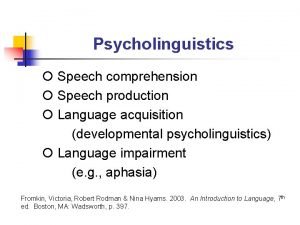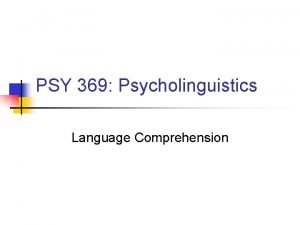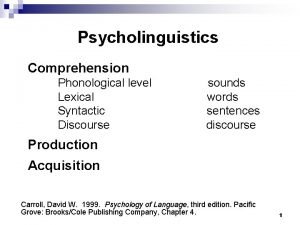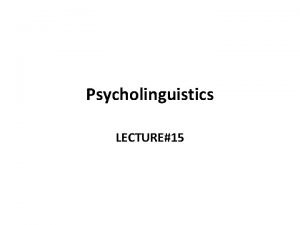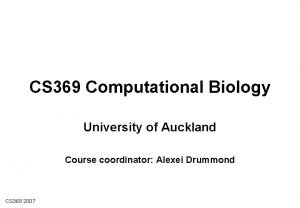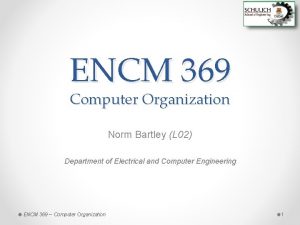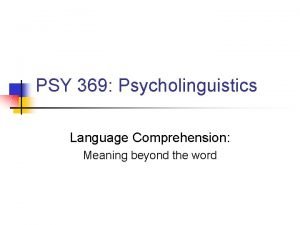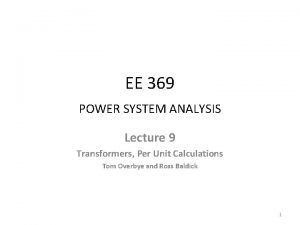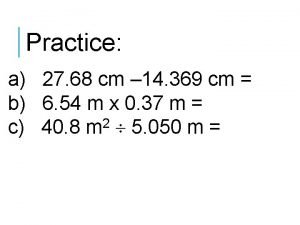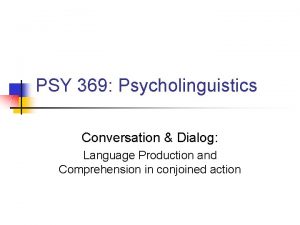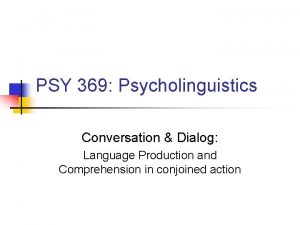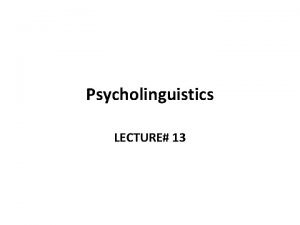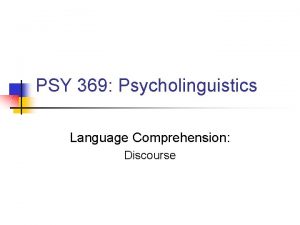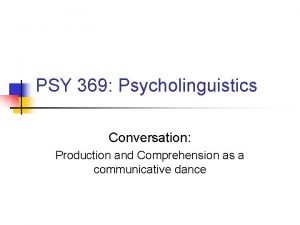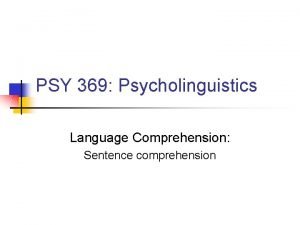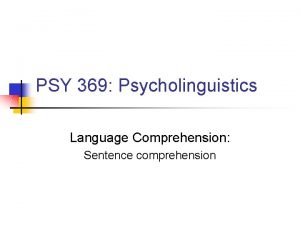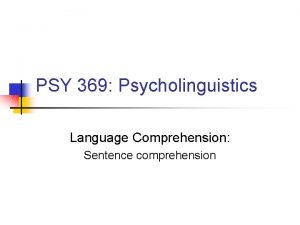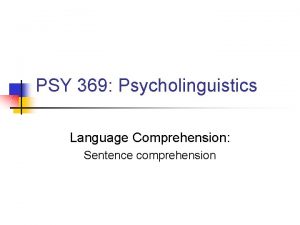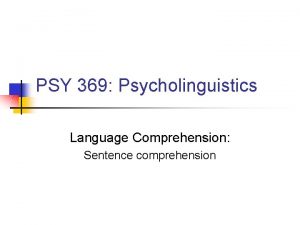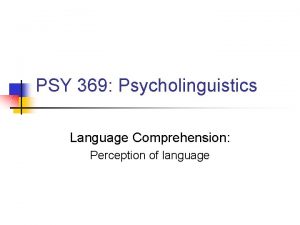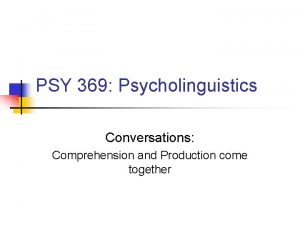PSY 369 Psycholinguistics Language Production Comprehension Conversation Dialog
















- Slides: 16

PSY 369: Psycholinguistics Language Production & Comprehension: Conversation & Dialog

Dialog is the key n Why so little research on dialog? n Most linguistic theories were developed to account for sentences in de-contextualized isolation n Dialog doesn’t fit the competence/performance distinction well Hard to do experimentally n Conversations are interactive and largely unplanned Pickering and Garrod (2004) n Proposed that processing theories of language comprehension and production may be flawed because of a focus on monologues

Processing models of dialog n Pickering and Garrod (2004) n Interactive alignment model n n Alignment of situation models is central to successful dialogue Alignment at other levels is achieved via priming n n Alignment at one level can lead to alignment at another Model assumes parity of representations for production and comprehension

Assumptions of the model 1. Alignment of situation models comes about via an automatic, resource-free priming mechanism 2. Representational parity between comprehension and production 3. Alignment at one level leads to alignment at other (interconnected) levels 4. There is no need for explicit perspective-taking in routine language processing

Assumptions of the model 1. Alignment of situation models comes about via an automatic, resource-free priming mechanism Garrod & Anderson (1987) The maze game n Pairs played a co-operative computer game n n n Move position markers through a maze of boxes connected by paths Each player can only see his/her own start, goal and current positions Some paths blocked by gates (obstacles) which are opened by switches Gates and switches distributed differently for each player Players must help their partner to move to switch positions, to change the configuration of the maze

Assumptions of the model 1. Alignment of situation models comes about via an automatic, resource-free priming mechanism Garrod & Anderson (1987) The maze game 1 -----B: . . Tell me where you are? 2 -----A: Ehm : Oh God (laughs) 3 -----B: (laughs) 4 -----A: Right : two along from the bottom one up: 5 -----B: Two along from the bottom, which side? 6 -----A: The left : going from left to right in the second box. 7 -----B: You're in the second box. 8 -----A: One up : (1 sec. ) I take it we've got identical mazes? 9 -----B: Yeah well : right, starting from the left, you're one along: 10 ----A: Uh-huh: 11 ----B: and one up? 12 ----A: Yeah, and I'm trying to get to. . .

Assumptions of the model 1. Alignment of situation models comes about via an automatic, resource-free priming mechanism Garrod & Anderson (1987) The maze game 41 ----B: You are starting from the left, you're one along, one up? (2 sec. ) 42 ----A: Two along : I'm not in the first box, I'm in the second box: 43 ----B: You're two along: 44 ----A: Two up (1 sec. ) counting the : if you take : the first box as being one up : 45 ----B: (2 sec. ) Uh-huh : 46 ----A: Well : I'm two along, two up: (1. 5 sec. ) 47 ----B: Two up ? : 48 ----A: Yeah (1 sec. ) so I can move down one: 49 ----B: Yeah I see where you are:

Assumptions of the model 1. Alignment of situation models comes about via an automatic, resource-free priming mechanism Garrod & Anderson (1987) The maze game n Path descriptions (36. 8%) n n Co-ordinate descriptions (23. 4%) n n I’m at C 4 Line descriptions (22. 5%) n n See the bottom right, go two along and two up I’m one up on the diagonal from bottom left to top right Figural descriptions (17. 3%) n See the rectangle at the bottom right, I’m in the top left corner of that

Assumptions of the model 1. Alignment of situation models comes about via an automatic, resource-free priming mechanism Garrod & Anderson (1987) The maze game n n Pairs converge on different ways of describing spatial locations n Entrainment on a particular conceptualization of the maze n But little explicit negotiation n Entrainment increases over the course of a game Description schemes as local ‘languages’ n n Rules for mapping particular expressions onto interpretations with respect to a common discourse model Once the meaning of a particular expression is fixed, players try to avoid an ambiguous use of that expression

Assumptions of the model 1. Alignment of situation models comes about via an automatic, resource-free priming mechanism Garrod & Anderson (1987) The maze game n Entrainment emerges from a simple heuristic n n Formulate your output using the same rules of interpretation as those needed to understand the most recent input Representations used to comprehend an utterance are recycled during subsequent production n n Leads to local consistency Helps to establish a mutually satisfactory description scheme with least collaborative effort

Assumptions of the model 2. Representational parity between comprehension and production n Parity important for interactive alignment n n n We don’t go around repeating other people’s utterances! Comprehension-to-production priming (BPC, 2000) n Priming from sentences which were only heard n Suggests that representations shared across modalities Equivalent to production-to-production effects? n E. g. Bock (1986), syntactic priming in language production tasks

Assumptions of the model 3. Alignment at one level leads to alignment at other Bigger priming effect (interconnected) levels n Cleland & Pickering (2003) n Semantic boost n n n Primes either pre (the red sheep) or post nominally (the sheep that is red) modified NPs Same (sheep to sheep), semantically related (goat to sheep), unrelated (knife to sheep) Branigan, Pickering, & Cleland (2000) n Lexical boost similar effect with same verb when the prime noun is semantically related to the noun in the target

Assumptions of the model 4. There is no need for explicit perspective-taking in routine language processing n If communication is successful, interlocutors’ situation models come to overlap n Implicit common ground n Overlap may be small to begin with n But via alignment, it increases over the course of a conversation n n What looks like audience design is simply a by-product of good alignment Full common ground only consulted when there are sufficient processing resources available

Summary n “People use language for doing things with each other, and their use of language is itself a joint action. ” Clark (1996, pg 387) n Conversation is structured n n But, that structure depends on more than one individual Models of language use (production and comprehension) need to be developed within this perspective n Interactive Alignment model is a new theory attempting to do just this

Review for Exam 4 n n n Chapters 13, 14, 15 (read 16 for interest, but I won’t test on it) Same format as the last 3 exams General topics: n Language Production Conversation & dialog n I have fixed the link to the review sheet n

Review for Exam 4 n Language production n n n Paradox: form over meaning is preserved Speech errors - observational & experimental Tip-of-the-tongue Lexical bias Grammaticality constraint Models of speech production n Levelt’s model Dell’s model Lexical bias effect, mixed errors
 Xxxxyyyzzzz
Xxxxyyyzzzz Puldow
Puldow Comprehension of words in psycholinguistics
Comprehension of words in psycholinguistics Apa yang dimaksud dengan pre production process
Apa yang dimaksud dengan pre production process Ragam dialog (dialog style)
Ragam dialog (dialog style) Dialog style
Dialog style Language loss in psycholinguistics
Language loss in psycholinguistics The expression of congratulation
The expression of congratulation 369 times 2
369 times 2 Cs 369
Cs 369 369
369 Ge power management
Ge power management Norm bartley
Norm bartley Beyond comprehension meaning
Beyond comprehension meaning 369 power
369 power Bio 369
Bio 369 369 project
369 project
